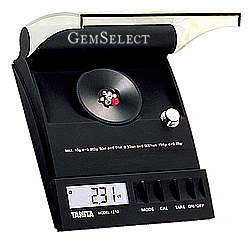Gemstone Carat Weight
When it comes to purchasing gemstones, one of the most important factors to consider is carat weight. Gemstones are measured in metric carats, with one carat being equivalent to 0.2 grams, approximately the weight of a paperclip. It is important not to confuse carat with karat, which pertains to gold purity, such as "18K gold." Similar to how a dollar is divided into 100 pennies, a carat is divided into 100 points. Gemstone carat weight is one of the key factors in determining the value and size of a gemstone, but it’s often misunderstood. While many people focus on the carat weight alone, it’s important to understand how it relates to the overall appearance and quality of a gemstone.
 |
| Gemstone Carat Weight Scale |
The English word carat comes from the Greek word for keration ('little horn'), referring to the shape of the seedpods of the carob tree. These seeds are small and uniform in weight; therefore, they were a standard for weighing gemstones in early times.
Around 1920, the metric carat was adopted as an international standard. One carat equals a fifth of a gram (0.20 grams), so there are five carats to the gram.
Tavernier's Law
Generally, as a gemstone's carat weight increases, so does the price per carat. A fun way to look at stone value is the following: Since the late 14th century there has been a law for diamonds that is known as the 'Indian Law' or 'Tavernier's Law':
Weight² x C = Price per stone
The following shows how the price of a diamond might increase with this formula applied to a $1000 a carat base price.
|
